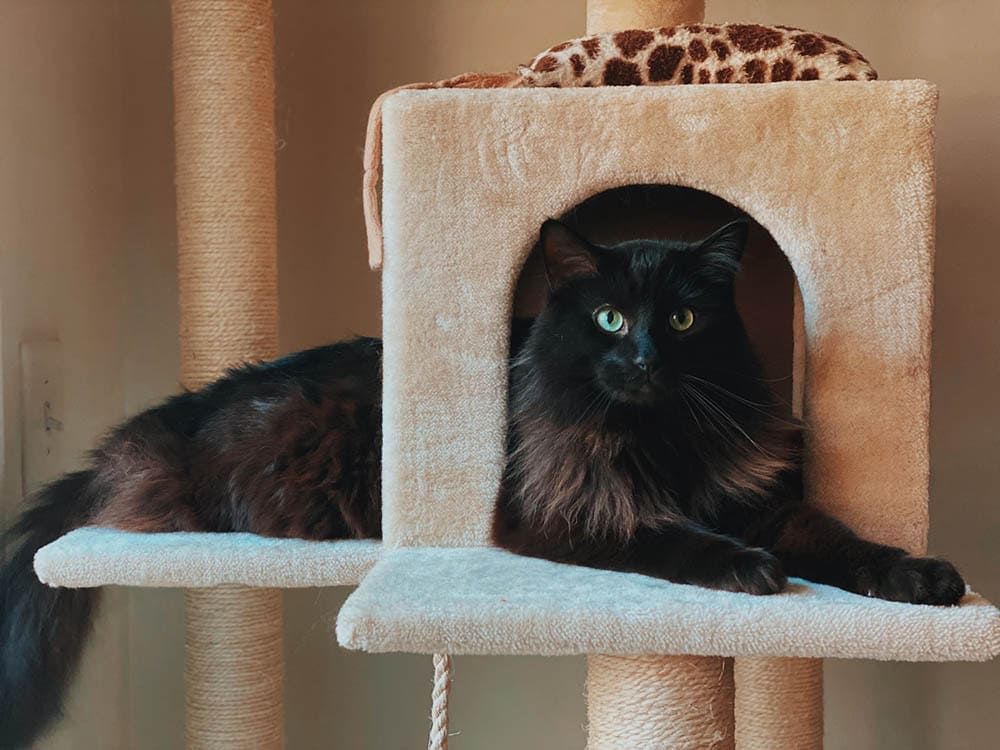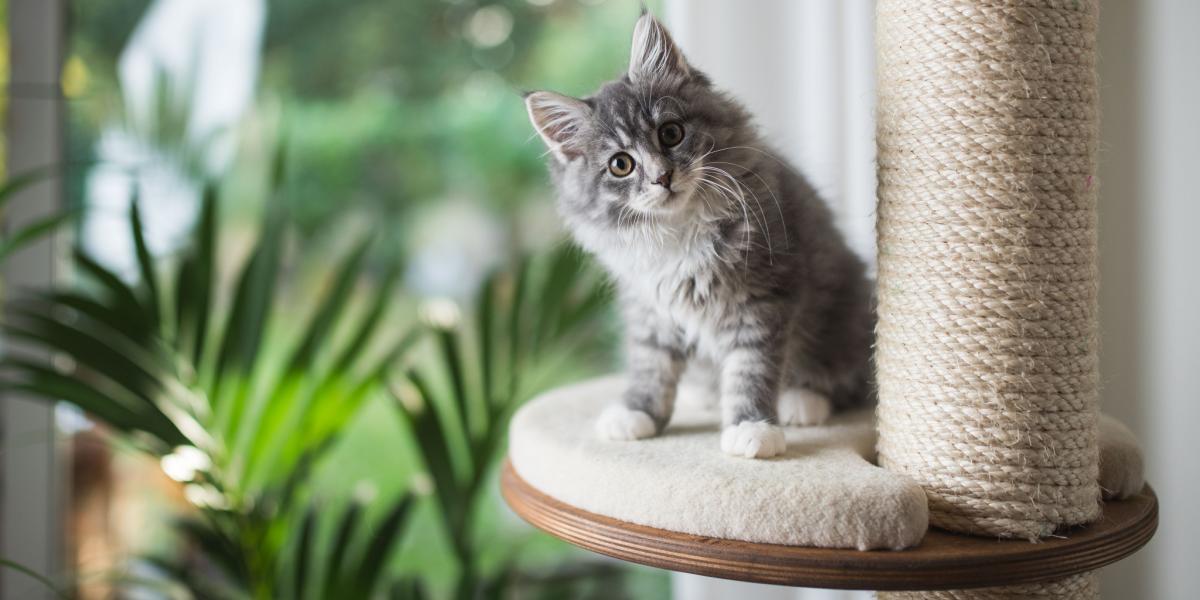Will Cats Use A Used Cat Tree? Imagine you’ve just gotten a new cat and you’re in need of a cat tree, but the price tags at the pet store are a bit too steep for your budget. So, you turn to the idea of getting a used cat tree instead. But here comes the question: will your furry friend actually use a pre-owned cat tree? In this article, we’ll explore the likelihood of cats embracing second-hand furniture and provide you with some insights on what to consider before making your decision.
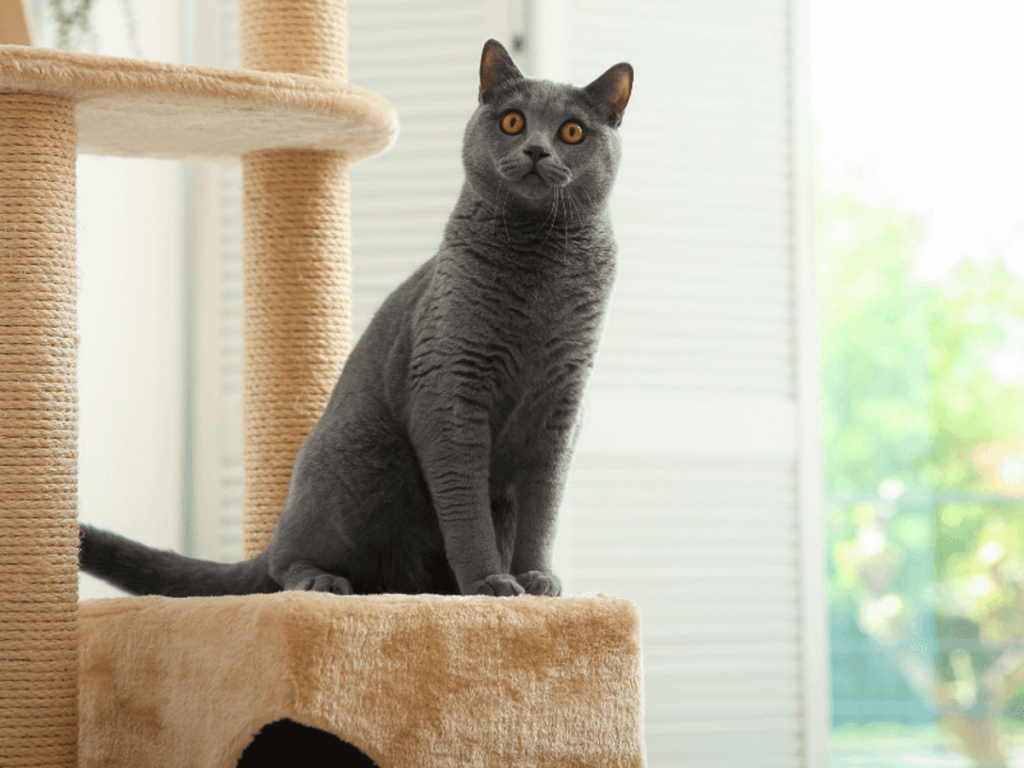
The Benefits of a Cat Tree
Physical and Mental Stimulation
A cat tree provides numerous benefits to your feline friend. One of the key advantages is the physical and mental stimulation it offers. Cats are natural climbers and jumpers, and a cat tree allows them to engage in these instinctual behaviors. Jumping from platform to platform and climbing up the vertical structure promotes exercise and helps to keep your cat physically active. Additionally, the different levels of the cat tree provide mental stimulation as your cat explores and navigates the various perches and hideaways.
Scratching Post Alternative
Cats have a natural urge to scratch, and providing them with a dedicated scratching post is essential for maintaining their claw health. A cat tree often includes scratching surfaces such as sisal rope or carpeted areas, which can serve as an excellent alternative to your furniture. By encouraging your cat to scratch on the tree, you can protect your belongings while satisfying their natural instinct.
Vertical Territory
Cats are territorial animals, and they often seek out high vantage points to survey their surroundings and establish their domain. A cat tree offers the perfect solution for providing vertical territory in your home. By allowing your cat to perch on the different levels of the tree, you are giving them a sense of ownership and providing them with a safe and elevated space where they can observe their environment comfortably.
Soothing Comfort
Cats are known for their love of cozy spaces, and a cat tree provides just that. With comfortable perches, enclosed hideaways, and soft cushions, a cat tree offers a soothing and comforting retreat for your feline companion. Whether they want to curl up for a snooze or simply relax and observe their surroundings, the tree provides a dedicated space tailored to their needs.
Factors Affecting Cat Tree Usage
Scent Marking
Cats are highly scent-driven creatures, and they use scent marking to communicate and claim their territory. When introducing a used cat tree into your home, lingering scents from other cats may deter your feline friend from using it. To overcome this obstacle, you can try scent marking the tree with your cat’s personal scent. Rubbing a familiar blanket or toy on the tree can help associate it with your cat and make it more enticing for them.
Condition and Cleanliness
The condition and cleanliness of the cat tree can significantly impact whether your cat will use it or not. Inspect the tree for any signs of wear and tear, such as loose or unstable platforms, frayed ropes, or worn-out cushions. A well-maintained cat tree is more likely to attract your cat’s attention and provide a safe and enjoyable experience. Regular cleaning is also necessary to remove any dirt or debris that may accumulate on the tree.
Placement and Accessibility
Where you position the cat tree in your home plays a crucial role in whether your cat will utilize it or not. Cats prefer to have their perches and hideaways located in areas where they can observe their surroundings comfortably. Placing the tree near a window or in a room with high foot traffic can make it more appealing to your cat. Additionally, consider the accessibility of the tree. Cats prefer easy and convenient access to their perches, so ensure that the tree is not obstructed by furniture or obstacles.
Multi-Cat Households
If you have multiple cats, the dynamics between them can affect their usage of a cat tree. Some cats may be more dominant and claim the top perches, while others may prefer the lower levels. It is important to provide enough perching spots and hideaways for each cat to ensure they all feel comfortable using the tree. Additionally, observe your cats’ behavior to ensure that there are no territorial disputes or bullying occurring around the tree, as this can discourage usage.
Adjusting a Cat to a Used Cat Tree
Introducing the Cat Tree
When introducing a used cat tree to your cat, it is essential to do so gradually to avoid overwhelming them. Start by placing the tree in a quiet and familiar area of your home where your cat spends a lot of time. Allow them to explore the tree at their own pace without any pressure. Some cats may take to the tree immediately, while others may need more time to adjust. Patience is key during this process.
Adding Familiar Scents
To make the cat tree more appealing and familiar to your cat, consider adding scents that they associate with comfort and security. Rubbing a blanket or cloth with your cat’s scent and placing it on one of the perches can help create a sense of familiarity and encourage them to use the tree. Additionally, you can sprinkle a bit of catnip on the tree to entice their interest and make it a more enticing space.
Encouraging Exploration
Encourage your cat to explore the different levels and features of the cat tree by using treats or toys. Place treats on various perches or in the hideaways to entice your cat to climb and investigate. Additionally, dangling toys from different platforms can pique their curiosity and motivate them to engage with the tree. Positive reinforcement and rewards can go a long way in helping your cat to feel comfortable and confident on the tree.
Positive Reinforcement
Rewarding your cat for using the cat tree is crucial in reinforcing the behavior and ensuring its continued usage. Whenever you see your cat using the tree, praise them, give them treats, or offer their favorite toys as a reward. Positive reinforcement creates positive associations with the tree and encourages your cat to view it as a desirable and enjoyable space. Consistency and repetition are key when using positive reinforcement techniques.
Tips for Selling or Recycling a Used Cat Tree
Cleaning and Sanitizing
If you decide to sell or recycle a used cat tree, it is important to clean and sanitize it thoroughly beforehand. Remove any detachable parts and wash them using pet-safe cleaning products or mild soapy water. For the structure itself, use a pet-safe disinfectant spray or wipe to eliminate any bacteria or odors. Pay attention to details such as scratching posts and cushions, ensuring they are clean and odor-free. A well-cleaned cat tree will be more appealing to potential buyers or more suitable for donation or recycling.
Repairing and Restoring
Before selling or recycling a used cat tree, inspect it for any damages or wear. If there are minor issues such as loose screws or torn upholstery, consider repairing or restoring them to improve the overall condition of the tree. Tighten any loose joints, reinforce unstable platforms, or replace worn-out parts if necessary. Repairing and restoring the cat tree not only enhances its appeal but also ensures its safety and functionality for the next user.
Finding Potential Buyers
If you choose to sell your used cat tree, there are various avenues to find potential buyers. Online platforms such as classified ads, pet-specific forums, or social media groups dedicated to pet accessories can be effective in reaching out to interested individuals. Be sure to provide accurate descriptions and clear photos of the cat tree to attract potential buyers. Additionally, consider offering a reasonable price or negotiating options to make the transaction more enticing.
Donating or Recycling
If selling your used cat tree is not a viable option, donating or recycling it can be an excellent alternative. Many animal shelters or rescue organizations welcome donations of cat trees to provide enrichment and comfort to the cats in their care. Reach out to local shelters or organizations to inquire about their donation requirements. If donation is not possible, recycling the cat tree ensures that it does not end up in a landfill and reduces waste.
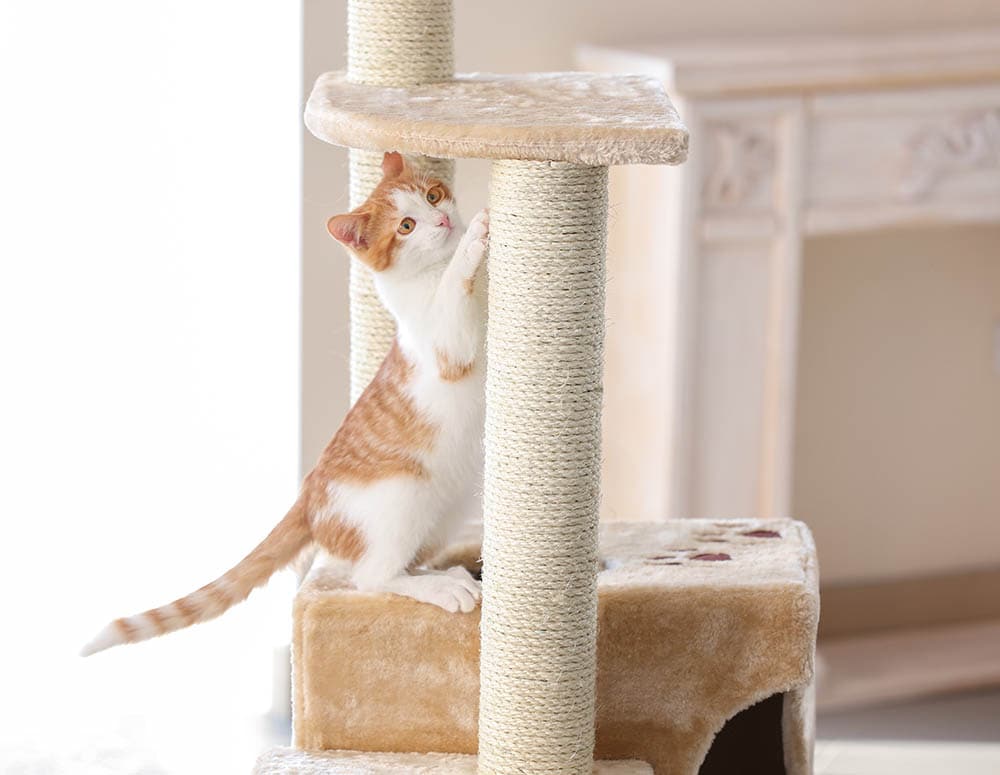
Answering Common Concerns
Can Cats Get Sick from a Used Cat Tree ,Will Cats Use A Used Cat Tree?
No, cats typically do not get sick from a used cat tree. However, it is important to clean and sanitize the tree before introducing it to your cat to prevent the spread of any potential diseases or parasites. Regular cleaning and maintenance will ensure that the cat tree remains a safe and healthy environment for your furry friend.
What if My Cat Doesn’t Use the Tree?
If your cat isn’t using the cat tree, it could be due to various factors such as scent marking, improper placement, or lack of familiarity. Consider addressing these issues by scent marking the tree with your cat’s scent, relocating it to a more desirable area, or gradually introducing your cat to the tree using positive reinforcement techniques. Patience and persistence are key when encouraging your cat to use the tree.
Should I Buy a Used Cat Tree?
Buying a used cat tree can be a cost-effective option, especially if it is in good condition and meets your cat’s needs. However, it is important to thoroughly inspect the tree for any damages, cleanliness, and stability before making a purchase. Ensure that the used cat tree provides adequate physical and mental stimulation, has appropriate scratching surfaces, and meets necessary safety requirements.
Are New Cat Trees Better?
New cat trees offer the advantage of being brand new, ensuring that they are clean, scratch-free, and in top condition. They may also come with manufacturer warranties or guarantees. However, whether a new cat tree is better than a used one depends on various factors such as budget, availability, and the specific needs of your cat. Both new and used cat trees can provide the physical and mental stimulation that cats require, so it ultimately comes down to personal preference and circumstances.
DIY Options for Cat Trees
Designing a Basic Cat Tree
Designing a basic cat tree can be a fun and rewarding DIY project. Start with a solid base, such as a wooden platform, and construct vertical posts using sturdy materials like PVC pipes or wooden dowels. Attach various levels or platforms at different heights to create perching spots for your cat. You can also incorporate additional features such as scratching posts, hideaway boxes, or dangling toys to enhance the tree’s functionality and appeal.
Choosing Safe and Durable Materials
When opting for a DIY cat tree, it is crucial to choose safe and durable materials. Avoid toxic substances or materials that could be harmful to your cat, such as treated wood or adhesive products with harmful fumes. Opt for pet-friendly materials like sisal rope for scratching surfaces and non-toxic glues or screws for assembly. Keep in mind that durability is important, as cats can be rough on their play structures.
Adding Custom Features
Adding custom features to your DIY cat tree can make it even more enticing and enjoyable for your cat. Consider attaching soft cushions or blankets to the perches for added comfort. Hideaway boxes or tunnels can provide cozy spaces for your cat to retreat and relax. Incorporating various textures and materials can also provide sensory stimulation, such as faux grass, carpet, or fleece. Get creative and tailor the tree to your cat’s preferences.
Budget-Friendly Alternatives
If budget is a concern, there are several budget-friendly alternatives to traditional cat trees. Repurposing existing furniture, such as bookshelves or ladders, can provide vertical spaces for your cat to climb and explore. Adding carpet or sisal rope to these structures can transform them into functional and attractive cat climbing areas. Utilizing wall shelves or installing wall-mounted perches can also save space while offering vertical territory for your cat.
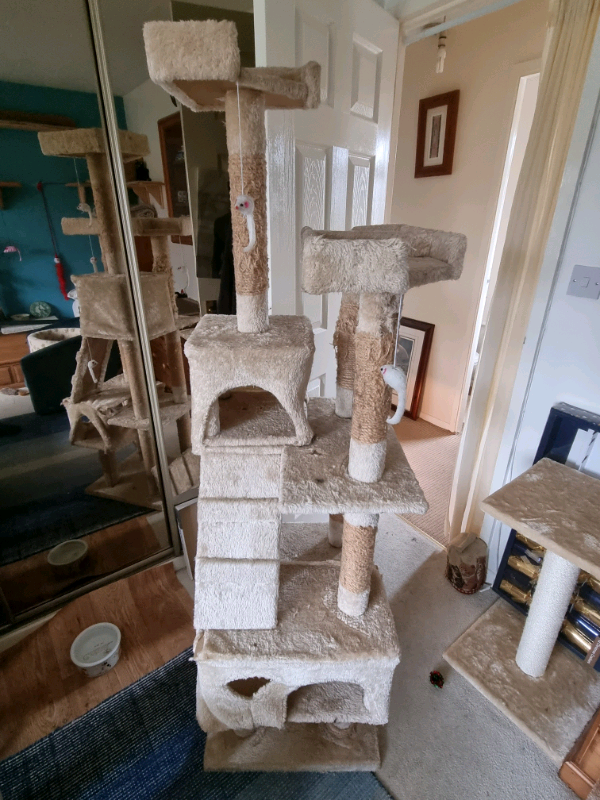
Alternatives to Cat Trees
Cat Shelves and Wall-Mounted Perches
Cat shelves and wall-mounted perches are excellent alternatives to cat trees, particularly for those with limited space. These options utilize vertical wall space, providing cats with elevated areas to climb, perch, and observe their surroundings. Cat shelves can be easily installed and offer the flexibility to create unique configurations tailored to your home’s layout and your cat’s preferences. Wall-mounted perches can also double as decorative elements to enhance your home’s interior design.
Cat Condos and Hideaway Beds
Cat condos and hideaway beds provide cozy and enclosed spaces for cats to retreat and relax. These alternatives typically feature a combination of perches, hideaways, and scratching surfaces. Cat condos are freestanding structures that offer multiple levels and compartments, while hideaway beds are single cozy spaces that can be placed on the floor or elevated surfaces. These options are particularly suitable for cats that prefer privacy or enjoy a sense of security in enclosed spaces.
Window Hammocks and Suction Cup Perches
For cats who enjoy observing the world outside, window hammocks and suction cup perches are great alternatives. Window hammocks attach to windows using suction cups and provide a comfortable and elevated space for cats to relax and enjoy the view. Suction cup perches offer similar functionality, allowing cats to perch on windows or other smooth surfaces. These alternatives enable cats to bask in the sunlight, watch birds, and engage with the outdoor environment.
Interactive Toys and Puzzle Feeders
While not a physical structure like a cat tree, interactive toys and puzzle feeders can provide mental stimulation and enrichment for cats. These alternatives engage cats’ natural hunting instincts and require problem-solving skills, keeping them mentally sharp and entertained. Puzzle feeders dispense food or treats in a challenging manner, encouraging cats to work for their rewards. Interactive toys with moving parts or hidden compartments provide hours of interactive play and prevent boredom.
Caring for Your Cat’s Tree
Regular Cleaning and Maintenance
To ensure the longevity and hygiene of your cat’s tree, regular cleaning and maintenance are essential. Vacuum or brush the tree regularly to remove loose hair, dirt, and debris. Inspect and tighten any loose screws or bolts to maintain stability. Clean the cat tree’s surfaces, perches, and hideaways periodically using pet-safe cleaning products or mild soap and water. Regular cleaning helps prevent the buildup of bacteria, odors, and allergens.
Replacing Worn-out Parts
Over time, certain parts of the cat tree may become worn or damaged, compromising its stability and safety. Inspect the tree regularly and replace any frayed ropes, torn upholstery, or unstable platforms. Consider replacing any worn-out cushions or padding to maintain the comfort and appeal of the tree. By promptly addressing and replacing worn-out parts, you ensure your cat’s continued enjoyment and safety.
Monitoring Safety and Stability
Safety and stability are paramount when it comes to cat trees. Regularly inspect the structure for any signs of instability, such as wobbling or swaying. Ensure the tree is placed on a level surface and that the base is sturdy. Monitor your cat’s usage of the tree and watch for any unusual behavior, such as avoiding certain areas or platforms. Cats can be adventurous climbers, so it is crucial to maintain the structural integrity and stability of the cat tree for their safety.
Cat Tree Safety Tips
To ensure your cat’s safety while using a cat tree, follow these important tips:
- Choose a cat tree with sturdy construction and high-quality materials.
- Ensure the tree’s stability by placing it on a level surface and securing it if necessary.
- Regularly inspect and maintain the tree, checking for loose parts or signs of wear.
- Place the cat tree away from any hazards or obstructions that could cause injury.
- Supervise your cat’s initial usage of the tree to ensure they adapt to it safely.
- Place the tree in an area with good visibility, allowing you to monitor your cat’s activity.
- Avoid placing the tree near dangerous or breakable objects that could be knocked over.
- Be cautious of any dangling cords or strings that can pose a strangulation risk.
- If the cat tree has multiple levels, ensure that the perches or platforms can support your cat’s weight.
- If introducing a new cat tree, gradually acclimate your cat to avoid overwhelming them.
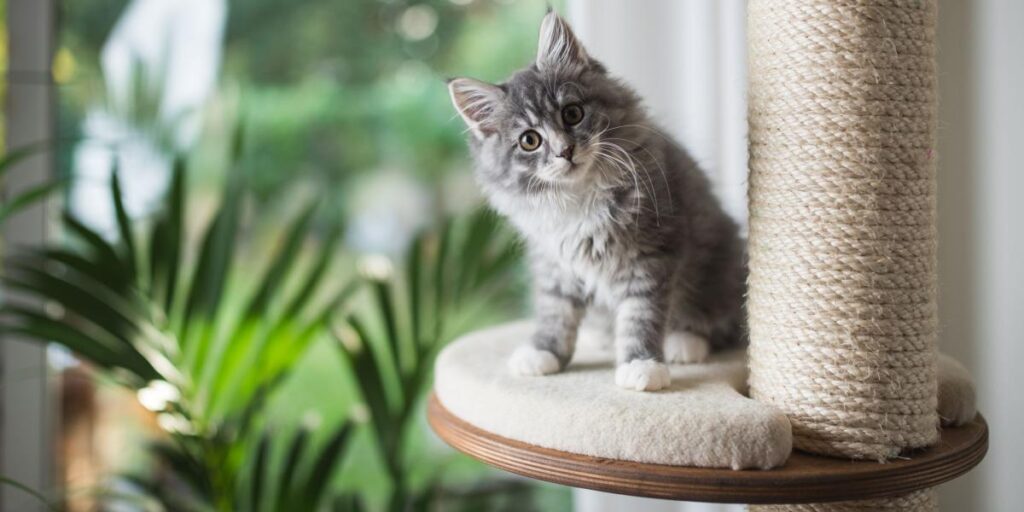
Benefits of Secondhand Cat Trees
Cost-Effective Option
One of the significant benefits of purchasing a secondhand cat tree is the cost savings. Cat trees can be quite pricey when bought new, but by opting for a used one, you can often find a quality tree at a fraction of the original price. This makes it an affordable option for cat owners on a budget or those looking to save some money while still providing their cats with the benefits of a cat tree.
Eco-Friendly Choice
Choosing a secondhand cat tree is an eco-friendly choice. By giving a used tree a new home, you are extending its lifespan and reducing waste. The production and disposal of cat trees contribute to environmental issues, including deforestation and landfill waste. By reusing a cat tree, you are actively participating in sustainability efforts and minimizing your carbon footprint.
Prevents Landfill Waste
When cat trees end up in landfills, they contribute to the growing waste problem. By purchasing a secondhand cat tree, you are helping to prevent unnecessary waste and extending the tree’s usability. This reduces the demand for new cat trees and ultimately reduces the environmental impact associated with manufacturing, shipping, and disposing of these products.
Supports Animal Shelters
Donating or purchasing a secondhand cat tree can directly support animal shelters or rescue organizations. Many shelters rely on donations to provide enrichment and comfortable spaces for the cats in their care. By donating your used cat tree, you are giving shelter cats a valuable resource and helping to enhance their quality of life. Alternatively, purchasing a secondhand cat tree from a shelter’s thrift store or donation center contributes to their fundraising efforts and supports their vital work.
Conclusion
Cat trees offer numerous benefits to both cats and their owners. From physical and mental stimulation to providing vertical territory and soothing comfort, cat trees play a significant role in a cat’s well-being. Factors such as scent marking, cleanliness, placement, and accessibility can affect a cat’s usage of a cat tree, but with proper adjustment, positive reinforcement, and attention to detail, cats can be easily acclimated to a used cat tree.
Whether you choose to sell, donate, or recycle a used cat tree, ensuring its cleanliness and functionality is essential. Cleaning and sanitizing the tree, repairing any damages, and finding potential buyers or donation opportunities are important steps to consider. Answering common concerns about used cat trees addresses any hesitations pet owners may have regarding their usage.
For those looking for alternatives, DIY cat trees, cat shelves, and wall-mounted perches provide creative and budget-friendly options. Additionally, caring for your cat’s tree, monitoring safety, and regularly maintaining it contribute to a long-lasting and enjoyable experience for both you and your furry friend.
Overall, considering secondhand cat trees offers cost savings, eco-friendly choices, waste prevention, and support for animal shelters. By embracing the benefits of secondhand cat trees, you can provide your cat with a stimulating and comfortable environment while contributing to a more sustainable future.
